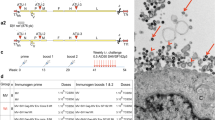Abstract
Recent advances in molecular genetics have led to the possibility of using large DNA viruses, such as vaccinia virus, as a biological delivery system for immunizing man against unrelated diseasecausing agents1–7. When live vaccinia virus recombinants expressing the hepatitis B virus surface antigen (HBsAg)8,9, the influenza A virus haemagglutinin10, the herpes simplex virus (HSV) type 1 D glycoprotein11,12, the rabies virus G glycoprotein13,14 and the vesicular stomatitis virus G glycoprotein15 were used for immunization, animals were protected upon challenge with the appropriate pathogenic agent. A major concern with using such vaccines, however, stems from the previously documented vaccinia virusassociated post-immunizing complications16. We present here experimental evidence that thymidine kinase-negative (TK−) vaccinia virus recombinants, constructed by inserting a variety of DNA coding sequences into the vaccinia virus tk gene, are less pathogenic for mice than wild-type virus.
This is a preview of subscription content, access via your institution
Access options
Subscribe to this journal
Receive 51 print issues and online access
$199.00 per year
only $3.90 per issue
Buy this article
- Purchase on SpringerLink
- Instant access to full article PDF
Prices may be subject to local taxes which are calculated during checkout
Similar content being viewed by others
References
Stow, N. D., Subak-Sharpe, J. H. & Wilkie, N. M. J. Virol. 28, 182–192 (1978).
Post, L. E. & Roizman, B. Cell 25, 227–232 (1981).
Sam, C.-K. & Dumbell, K. R. Annls Virol. Inst. Pasteur, Paris 132E, 135–150 (1981).
Weir, J. P., Bajszar, G. & Moss, B. Proc. natn. Acad. Sci. U.S.A. 79, 1210–1214 (1982).
Nakano, E., Panicali, D. & Paoletti, E. Proc. natn. Acad. Sci. U.S.A. 79, 1593–1596 (1982).
Mackett, M., Smith, G. L. & Moss, B. Proc. natn. Acad. Sci. U.S.A. 79, 7415–7419 (1982).
Panicali, D. & Paoletti, E. Proc. natn. Acad. Sci. U.S.A. 79, 4927–4931 (1982).
Smith, G. L., Mackett, M. & Moss, B. Nature 302, 490–495 (1983).
Moss, B., Smith, G. L., Gerin, J. L. & Purcell, R. H. Nature 311, 67–69 (1984).
Smith, G. L., Murphy, B. R. & Moss, B. Proc. natn. Acad. Sci. U.S.A. 80, 7155–7159 (1983).
Paoletti, E., Lipinskas, B. R., Samsonoff, C., Mercer, S. & Panicali, D. Proc. natn. Acad. Sci. U.S.A. 81, 193–197 (1984).
Cremer, K., Mackett, M., Wohlenberg, C., Notkins, A. L. & Moss, B. Science 228, 737–739 (1985).
Kieny, M. P. et al. Nature 312, 163–166 (1984).
Wiktor, T. J. et al. Proc. natn. Acad. Sci. U.S.A. 81, 7194–7198 (1984).
Mackett, M., Yilma, T., Rose, J. K. & Moss, B. Science 227, 433–435 (1985).
Beale, A. J. Nature 302, 476–477 (1983).
Weir, J. P. & Moss, B. J. Virol. 46, 530–537 (1983).
Field, H. J. & Wildy, P. J. Hyg., Camb. 8l, 267–277 (1978).
Kit, S., Qavi, H., Dubbs, D. R. & Otsuka, H. J. med. Virol. 12, 25–36 (1983).
Klemperer, H. G., Haynes, G. R., Shedden, W. I. H. & Watson, D. H. Virology 31, 120–128 (1967).
Thouless, M. E. & Wildy, P. J. gen. Virol. 26, 159–170 (1975).
Jamieson, A. T., Gentry, G. A. & Subak-Sharpe, J. H. J. gen. Virol. 24, 465–480 (1974).
Stevens, D. in American Type Culture Collection Catalogue of Strains. II 4th edn, 328 (American Type Culture Collection, Rockville, Maryland, 1983).
Moss, B., Winters, E. & Cooper, J. A. J. Virol. 40, 387–395 (1981).
Buller, R. M. L. et al. in Vaccines 85: Molecular and Chemical Basis of Resistance to Viral, Bacterial and Parasitic Diseases (eds Chanock, R. & Lerner, R.) 163–168 (Cold Spring Harbor Laboratory, New York, in the press).
DeVries, E. Postavaccinial Perivenous Encephalitis (Elsevier, Amsterdam, 1960).
Weber, G. & Lange, J. Dt. med. Wschr. 86, 1461–1468 (1961).
Wilson, G. S. in The Hazards of Immunization, 159–169 (Athlone, London, 1967).
Gurvich, E. B. Vilesova, I. S. Acta virol. 27, 154–159 (1983).
Joklik, W. K. Virology 18, 9–18 (1962).
Miller, R. G. Biometrika 60, 35–542 (1973).
Briody, B. A. Bact. Rev. 23, 61–95 (1959).
Lennette, E. H. & Schmidt, N. J. in Diagnostic Procedures for Viral Rickettsial and Chlamydial Infections, 291–293 (American Public Health Ass., Washington, DC, 1979).
Author information
Authors and Affiliations
Rights and permissions
About this article
Cite this article
Buller, R., Smith, G., Cremer, K. et al. Decreased virulence of recombinant vaccinia virus expression vectors is associated with a thymidine kinase-negative phenotype. Nature 317, 813–815 (1985). https://doi.org/10.1038/317813a0
Received:
Accepted:
Published:
Issue Date:
DOI: https://doi.org/10.1038/317813a0



